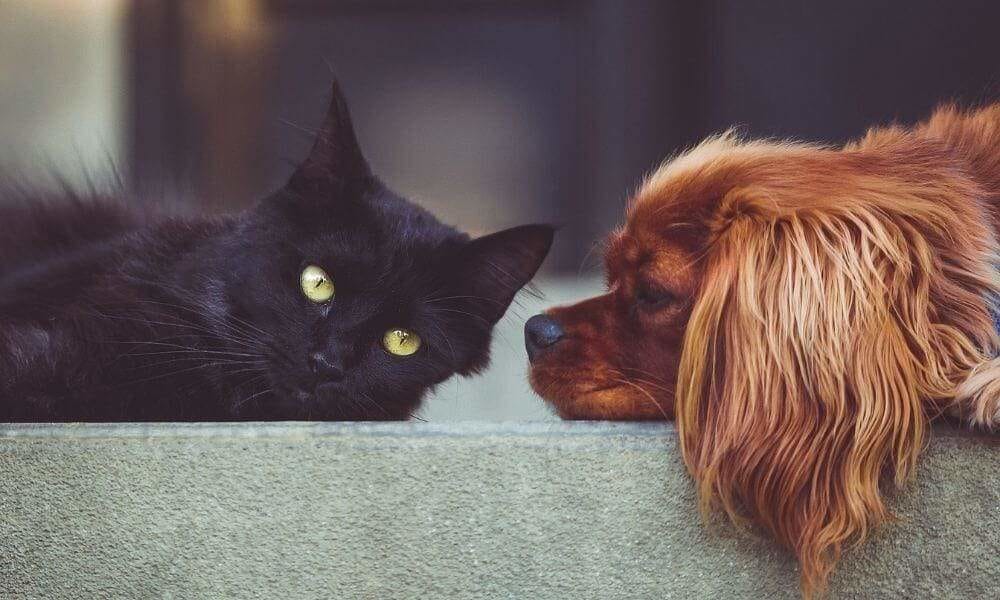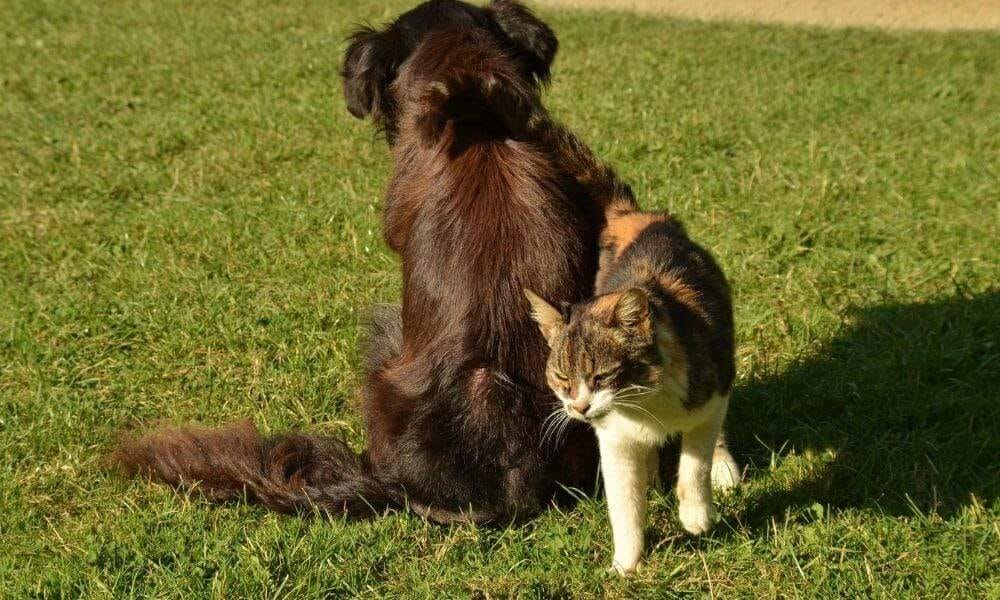Everyone has heard the phrase "fight like cats and dogs" - but with a little work, that doesn't have to be the reality for your pets. To help you, we've put together a list of things you can do to ensure your pets have a happy life together.

But before that, it is important to know the main differences between dogs and cats in order to know what you are getting into: this is important for you as well as for them.
Differences between dogs and cats: know them well to better associate them
How many differences between dogs and cats can you spot? Although they are both furry (most of the time), these two animals are very different from each other. In fact, the difference between dogs and cats may not be as easy to spot as you think.

The way dogs and cats exercise is very different
If you're looking for a workout buddy, a cat may not be your best choice. Although cats are known for their agility and will sometimes play games with you, they are not known for being athletic as such.
Dogs, on the other hand, generally make great exercise companions. Many breeds enjoy running and hiking, and will happily accompany you on any excursion.

Just because cats don't exercise doesn't mean they aren't agile. Cats have lean muscles and will leap or jump when stalking prey, even if that prey is a feather toy that you swing back and forth across the carpet.

Dog and cat games are also very different. While many dogs enjoy playing fetch, cats will often watch you throw a ball and then walk away, not wanting to participate in your game .
A fun game for a cat might be jumping to your feet when you're lying under the covers and sleeping. It should also be noted that cats are nocturnal animals, and they like to play at night, when your dog is probably snoring quietly.
Pack mentality versus lone mentality

Dogs are pack members, and throughout history they have worked in groups. This is why they consider their human master as the leader of the pack, who seeks to guide them and follows them closely.
Dogs tend to work together to get things done. Your dog will therefore get involved in your routines to get closer to you.

For their part, cats are solitary hunters. They are very independent creatures, often relying on their humans only for their basic needs of food and clean bedding. They are content to be alone for hours. To establish a bond with a cat, you often have to take the first step. Just because they aren't pack animals doesn't mean they don't enjoy having their backs scratched by their human family.
Character is one of the main differences between dogs and cats

During the day, your dog is active and playful. Although he may take a nap from time to time, he prefers to be by your side. A cat, on the other hand, sleeps for much of the day , preferring to switch to turbo time just before you go to bed.
Cats are more playful in the evening, but that doesn't mean there are also many cats who make time for their owners during the day. A routine helps your cat adapt to your schedule.
A major difference between dogs and cats is the way they express themselves. Your dog will bark, howl or growl, while the cat meows, hisses or purrs.

When giving warning signals, cats often arch their backs and the hairs on their backs may stand up. Dogs, on the other hand, show that they are alert by showing their teeth and fixing their gaze. Both animals usually make sounds, such as growling or bellowing, to warn another animal or human to keep their distance.

It is difficult to compare behaviors too closely, because, as with humans, the behavior and personality of dogs and cats can vary enormously from one individual to another, and the rule then becomes “invalid” a certain way.
Some cats are extroverted, others are introverted. Species and breed only determine part of behavior. The rest depends on their individual personality and the environmental factors in which they are raised each day.
Food is another difference between dogs and cats
Dogs and cats like to eat. However, cats need to ingest smaller and more frequent meals than dogs. It is important to understand your pet's nutritional needs. Consult your veterinarian to determine the ideal diet for your furry friend.
Physical differences between dogs and cats

The physical characteristics of each animal are obvious to the naked eye. To begin with, claws are proof of the difference between dogs and cats. Your dog's claws are more “blunt” than a cat's, simply because they are always out and the ground he walks on wears them down. A cat has very sharp and retractable claws which are used to protect itself and to hold on to objects, for example an object that it must climb.

Dogs and cats can be excellent hunters. However, the way they approach their prey is very different. Cats are climbers and use their claws to climb trees and, effortlessly, jump from high places. Dogs are land creatures. While some are known for jumping, dogs are more likely to use their noses to find their prey or their speed to catch it.
Dog and cat: different constraints
As you know, dogs and cats do their business differently, the former being more restrictive for you than the latter. In fact, when there is a storm, a cat that uses the litter box may win you over more quickly than a dog that needs to do its business outside and is very picky about the exact piece of grass on which he must "go". However, it is possible to train your dog at home. Cats learn to use a litter box quickly, often by instinct , and only need a few reminders.

Training shows the differences between dogs and cats
There is a common misconception that cats cannot be trained, but in reality many can be. However, cats often express their opinions and do not like to be dictated to. Remember that dogs are pack animals that follow their master's commands closely and willingly. Cats do not have the same obedience.
Cats are independent. It is important that all feline training sessions are very short, but be consistent and keep trying, as their memory is much longer than a dog's. Unlike cats, dogs can be trained in groups. They can also tolerate longer sessions to help them remember everything they have learned.

You may need to approach training differently with dogs and cats, but both species enjoy treats as a reward for their work.
Although dogs and cats are very different, they both make excellent companions. All they need is love and care from their parents to be happy and healthy animals.
So how do you get dogs and cats to live together in the same house?

Tip #1: Raise them together
One of the best ways to get dogs and cats to coexist is simply to raise them together . Puppies are easier to train than dogs and tend to be less confident.
They are therefore more likely to let their feline companions take the alpha position in the house. Of course, this isn't always possible, so if you have to deal with the introduction of adult cats and dogs, read on.

Tip #2: Make sure you give your cat its own territory
It is important that your cat has its own space in the house. This space will be especially important when you first introduce your pets to each other, but it will also continue to serve as a refuge when they need to escape and enjoy their free time.
If you live in a small space, don't worry about limiting the space your dog has access to. Since cats are natural climbers, you can use any vertical space in your home , whether it's a cat tree or a recently installed shelf. These two places are perfect for allowing your cat to observe your dog from a comfortable distance.

On the other hand, if you can and you live in an area that is relatively safe for your cat (spaced housing area, little road traffic, etc.), allow him to escape from the house if necessary. Sometimes cats need personal space and the ability to escape anything they perceive as stress or threat, including your favorite dog.
Note that this may also include conflict with other cats or other pets, construction work in the house, or unknown visitors in the house.
Unlimited access to the outside , for example through a cat flap, is a means of escape. Microchip or magnetic cat flaps can help keep your cat safe, so neighboring cats don't enter your home.
In short, any kind of stress on your cat should be avoided in order to ensure good cohabitation in the house, between dog and cat!
Tip #3: Introduce them to each other's things before face-to-face introductions

Before starting the face-to-face introduction, it is a good idea to introduce the other pet's toys and bedding. Animals use smell to become familiar with new things. This way, each animal will have the opportunity to get to know the other and satisfy its curiosity while avoiding potential fights that could break out if it investigated in the presence of the other.
Tip #4: Make introductions slowly
When the time comes for your cat and dog to meet in person, it's important to take it slowly. Just like with humans, first impressions are important. And for a successful first impression, food can be a great tool to make everything go well. The best time for your pets to meet is mealtime.

For the first meals, feed your animals on either side of a closed door. This way, they won't be able to see each other, but can still smell each other and begin to make positive associations between tasty food and their new friend.
Continue this for as long as you feel necessary - anywhere from a few days to a few weeks, depending on how your animals react - and then slowly introduce a visual element into the presentation process.
A simple way to do this is to feed your pets in the same room, but keep your dog on a leash. You will eventually remove all the barriers between the two and they should be able to live together nicely.
Tip #5: Keep Things Equal

Jealousy and resentment over toys, treats, and attention can have a huge impact on a cat and dog's relationship, so it's important to maintain a level playing field. This means you need to make sure your pets have access to the same amount of toys and treats, to keep things fair.
But this equality is not limited to physical objects: the time you spend with them should also be equal. For example, if you constantly make a fuss to your dog when you arrive home, your cat will quickly pick up on this and may begin to find ways to show his displeasure at this inequality - or vice versa.

Tip #6: Train your dog well
Before any introduction, it is important that your dog understands basic commands such as "sit", "stay", "down", "down" and "leash". The more he knows these commands, the easier the introductions will be, because he will be able to remain calm when meeting the cat.
When your dog interacts with your cat, be sure to redirect your dog's negative behaviors, including rough play and barking. Instead of scolding him, try distracting him with another activity or command and let him reset before returning to your cat.

These difficulties are explained by the dominated nature of most dogs when faced with a cat companion. More out of naive curiosity than aggression, they tend to want to go towards the cat who, very often, needs to maintain a little distance. So the more positive the situation, the more positive associations the dog will have not only with your cat, but also with all cats it meets.
Tip #7: Don’t let your cat scratch your dog just because it’s “funny”

We often see in dog/cat videos on Youtube , dogs frightened and mishandled by a cat with somewhat tyrannical behavior, which is only waiting for the dog to pass by to scratch or bite it. This situation is neither normal nor funny and if your dog is a victim of it, you should not let the situation continue, because it is clear that the dog is not comfortable if he has to skim the walls in the House.
The first option may simply be that the introduction went badly, but by systematically preventing your cat from scratching your dog , you will show that you do not accept the situation. Simply try to do it calmly by intervening first, then sending the cat to its home while leaving the dog its own space of freedom (it is not up to the dog to be punished for something that it does not He did not do it).

For example, you can put the cat in its own room for an hour. The second option is that your cat may not have decided to leave its territory to a dog, and in this case you have to decide what to do next so that everyone is happy. Unfortunately, not all cohabitations are made to last.
Tip #8: Separate Their Stuff
Even if they get along well after the first meeting, it's good to give them their own space. For your cat, this means having a private space for their litter box. Unfortunately, some dogs seem to be a little too interested in what's going on in the litter boxes.

If your dog tries to approach your cat while she is using the litter box, she may feel threatened and, if this happens regularly, she may avoid going there to relieve herself. The same goes for food. By feeding your animals in separate areas, you reduce the risk of food aggression.
The most important thing to remember when introducing your pets is that all cats and dogs are different - what works for one may not work for another.
Tip #9: Play with them as much as possible
Both dogs and cats need daily play time. So make sure to play with your dog, and with your cat , each animal enjoying its own time. As we told you, cats tend to have their crazy fifteen minutes
in the evening rather than during the day, unlike dogs, but your pet will know how to let you understand when he needs to play with you.

Cats, as born hunters, like to go after their prey, which is why they appreciate bait-shaped toys, like balls connected to a string, or even small lasers that you point at the wall. Dogs tend to like to bite a bone or a ball or run after it if you have a large garden. The more your animals exercise, the better their mood will be, a bit like us humans!
Finally, when possible, organize times where you have them play together. It’s an excellent way to maintain complicity between them, and to promote long-term cohabitation.
So, what do you think of dog/cat cohabitation?

If you're having trouble helping your pets develop a relationship, the best person you can turn to is your veterinarian. He or she will be able to give you appropriate advice or even put you in contact with a behavioral specialist. But in most cases, with a little patience, your cat and dog will be happily cohabiting in no time.

However, if despite all your efforts, cohabitation really does not work, perhaps know not to insist: we know, cohabitation that does not work is heartbreaking but the well-being of your animals is to be prioritized and you You can always find an alternative solution, such as a new adoption family for the animal you have just adopted. This way you will ensure everyone’s happiness!
Don't they say that it is sometimes better to live alone than in bad company? ;)